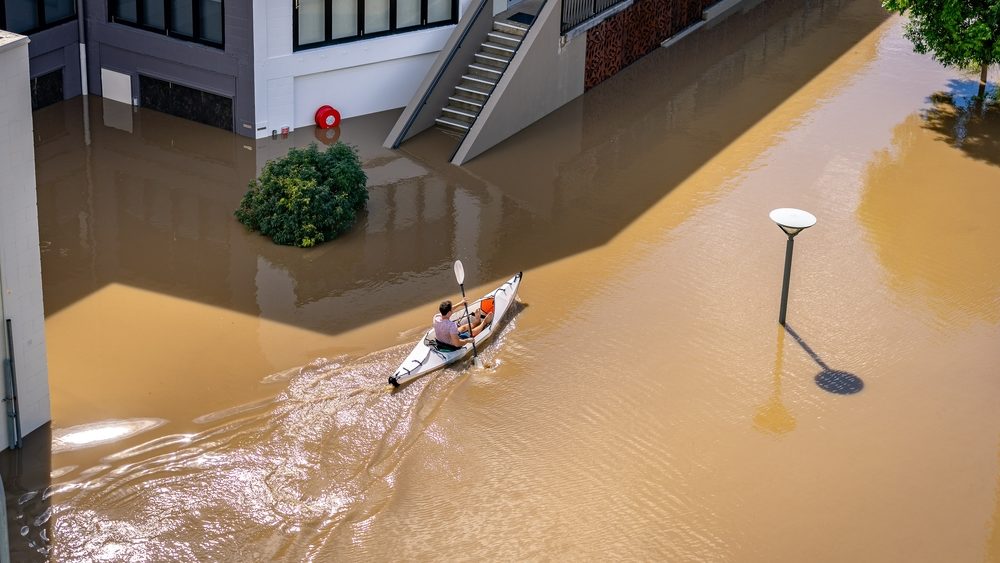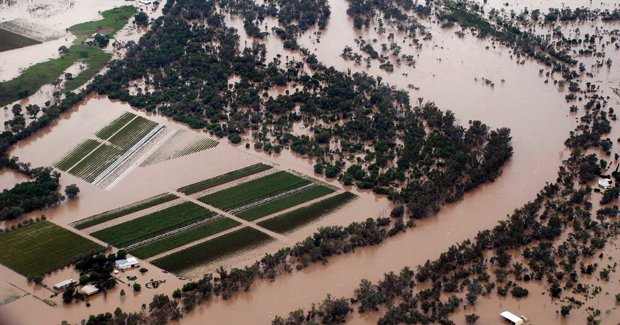Australia’s worst floods

Floods devastate local communities, but they also impact the entire economy – examples include the flood levy imposed in taxes following the south-east Queensland floods in 2010/2011, and also inflated banana prices after the same floods destroyed 75 per cent of the crop.
Professor Jonathan Nott, a palaeohazards expert at James Cook University in Cairns, says part of the problem is that we “continue to build in the path of floods,” regardless of history, and allow populations to increase in low-lying floodplains. While we are “very good at dealing with emergencies when they arise,” he says, “we are not so good at mitigating against disaster.”
Jonathan says that though floods are damaging for our agriculture and infrastructure, and can be fatal, they are also an important part of natural cycles, and help to distribute seeds, animals and sediments to new areas.
Dangerous floods have occurred in every Australian state over the last 150 years. Here’s a rundown of some of the worst in terms of loss of life and damage to infrastructure:
Australia’s worst floods in modern history:
1. Feb/March 2022: South East QLD, Wide Bay–Burnett and Western Downs QLD, and northern NSW
22 confirmed deaths, $4.3 billion in damages
A series of floods throughout February and March 2022 engulfed a region spanning over two states, with torrential rainfall and flash flooding leaving townships looking like war zones.
In Brisbane, Queensland’s capital, up to 15,000 properties were estimated to be damaged. Throughout South East Queensland, more than 20,000 homes were inundated
While Brisbane’s river peak was lower than the city’s 1974 and 2011 flood events at 3.85 metres, other towns broke records.
In Lismore in northern New South Wales, the Wilsons River peaked at 14.1 metres, leaving more than 10,000 people homeless across the Northern Rivers region.Damages from this series of floods have been totalled at $4.3 billion, the fourth highest damage bill from a natural disaster in Australia’s history,, according to the Insurance Council of Australia.

2. Dec 2010-Jan 2011: Brisbane and SE QLD
35 confirmed deaths, $2.38 billion in damage

With more than 200,000 people affected state-wide, the economic damage from this flood was estimated at $2.38 billion. Beginning with rains in September and then culminating with Category 1 Cyclone Tasha crossing the Far North Queensland coast on 24 December 2011, this was probably the most notorious flood in Australian history. In Brisbane, the river peaked at 4.46m on 13 January, flooding more than 28,000 homes and leaving 100,000 without power. Cyclone Yasi, which hit 3 February, caused further damage to already sodden towns.
3. Aug 1986 – Hawkesbury and Georges River Flood, NSW
6 dead, 10,000 homes damaged, an estimated $35M in damages
With the rainfall reaching 327.6mm in 24 hours, this day has been dubbed Sydney’s wettest day ever. The torrential rain created chaos, with flooded roads prompting many motorists to abandon their cars. Bus services were severely disrupted in the city and trains were halted due to flooded tunnels.
4. Jan-Apr 1974: Brisbane, QLD
14 deaths, 300 injured, 56 homes destroyed, an estimated $68 million in damages
After a particularly wet year in 1973, Brisbane was inundated with water when tropical cyclone Wanda hit the north of the city on 25 January 1974. By 29 January the Brisbane area had recorded 900mm of rain, with 314mm of rain falling in a 24-hour period. In the coming months the torrential rain swept down the east coast, causing floods in parts of NSW and Tasmania. The floods killed 14 people and injured 300 more, as well as destroying 56 homes and damaging 6000 others. In all, an estimated $68 million worth of damages occurred.
5. Feb 1955: Hunter Valley, NSW
24 deaths, 59 homes destroyed, 5200 homes flooded and 40,000+ people evacuated
The majority of deaths were around Singleton and Maitland, but most other river systems in the state were also in flood. These floods in the Hunter Valley have become symbolic in the Australian psyche of the dramatic nature of flood damage and rescue. About 15,000 people were evacuated from around these two towns, with more than 40,000 people being evacuated from a total of 40 towns. Five of the lives lost were due to electrocution during rescue operations.
6. 29 Nov 1934: Melbourne, VIC
36 deaths, 6000 homeless and 400+ buildings damaged
In late November 140mm of rain fell in Melbourne over a 48-hour period. To the east of Melbourne, in South Gippsland, 350mm fell over the same two-day period. The downpour resulted in landslides, evacuations and many submerged roads. Eighteen people drowned, with a further 18 killed by collapsing buildings and other dangers. More than 400 buildings were damaged in Melbourne and 6000 people were left homeless.
7. Apr 1929: Northern Tasmania
22 deaths, 1000 homes damaged, 25 bridges destroyed
The area of northern Tasmania is prone to heavy rainfall over short periods and up to 500mm of rain fell over three days. The floodwater carved a path across the region, destroying everything in its path, including vehicles, buildings and railroad tracks. It inflicted huge stock losses, the evacuation of 3500 people, while damaging 35 bridges and 1000 homes.
8. Feb 1927: Brisbane, Cairns, Townsville, QLD
47 deaths, 16 homes destroyed, an estimated £300,000 in damages
A tropical cyclone hit north of Cairns, causing major rainfall through Queensland, reaching as far as Toowoomba. The torrential rain, which fell from 9-17 February, led to the deaths of 47 people, damaged roads, railways, bridges and buildings – and completely destroyed 16 houses. There was also widespread loss of livestock. The estimated costs reported at the time were in the region of £300,000.
9. 27 Dec 1916: Clermont and Peak Downs, QLD
65 deaths, 10 homes destroyed, 50 buildings damaged and 10,000 livestock killed
A cyclone swept the coast along the Whitsunday Passage, bringing heavy rainfall to Clermont, Sapphire and Peak Downs. This usually flood-savvy town forgot to counter for the runoff from nearby catchments and creeks and the debris it carried with it at crushing speeds. The torrent smashed through houses and caused widespread damage. The lower part of Clermont was submerged, so the town was rebuilt on higher ground.
10. 15 Feb 1893: Ipswich, QLD
35 deaths, 300 people injured and two bridges destroyed
Often referred to as the Black February Flood, the extreme weather conditions and heavy rain were brought about by tropical Cyclone Bundinyong. The Crohamhurst weather station recorded 914mm of rain in a 24-hour period and another gauge recorded almost 889mm of rainfall in Brisbane’s water catchments. Both the Victoria Bridge and the Indooroopilly railway bridge collapsed, with 35 people killed and 300 injured.
11. June 1852: Gundagai, NSW
89 deaths, entire settlement of 250 people destroyed
There’s little doubt that the 2010/2011 Queensland floods were Australia’s most devastating in terms of damage to infrastructure and cost, but the worst loss of life happened in June 1852 when massive flooding on the Murrumbidgee River swept away most of the town of Gundagai, leaving just three houses standing. Eighty-nine people were killed, more than third of the population. The town was later rebuilt on higher ground.






